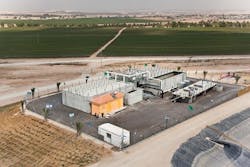Dewatering System Helps City Cope with Alum Sludge
The water treatment plant in Carbondale, IL, is a surface water plant that processes water from Cedar Lake. This plant was designed to handle a maximum flow of 8 mgd, although it normally sees flows of 4.25 mgd. Like a typical water treatment plant, Carbondale treats the incoming water with alum to coagulate the fine solids in the flow. The backwash from the gravity filters along with the clarifier sludge is sent to settling ponds.
The design of the plant was for three settling ponds to collect the solids separated by the plant's equipment. These lagoons operate in parallel, with waters discharged from the plant entering on one end and decanted on the opposite end to a receiving stream. There is one lagoon each for clarified sludge and filter backwash water, with a third lagoon out of service with the solids to be removed after it has dried out for several weeks.
The solids currently produced exceed the original design loading of the lagoons due to the use of different chemicals than the plant first used when it was built in 1994. Soon after the plant opened, the coagulation chemicals were changed, and in 1999 carbon and potassium permanganate were added to the raw water for pre-treatment. The lagoons filled with solids much more rapidly than planned, even with the lower than design flow through the plant.
The lagoons were designed to be excavated after being out of service and given time to dry, with the solids scooped up and deposited on the banks of the lagoons to allow water to drain back to the lagoon and solids to dry out further in the sun, before being hauled to the landfill. The plan was for the excavating to occur once every 3-5 years per lagoon.
However, because of the unanticipated amount of solids that were generated the plant had to excavate the lagoons much more often. It became necessary to remove the sludge from each lagoon once per year at a minimum. This was a costly, labor intensive process, but less expensive than other alternatives that were known to plant personnel, i.e., hauling sludge off with vacuum trucks or hiring a contractor to bring in mechanical separation equipment to dewater on site.
The weather also doesn't cooperate with the sludge removal process. Rainfall affects the ability of sludge to dry in the spring, and in the winter months the low temperatures interfere with excavated sludge drying.
Carbondale Water and Sewer staff began looking for an economical solution to their problem. Mark Odorizzi, sales manager of Vandevanter Engineering, made the city staff aware of a new type of dewatering device. He recommended the Sludge Mate dewatering system manufactured by Flo Trend Systems, of Houston, TX. Water and Sewer staff members visited two nearby towns to see the equipment in action. This equipment was shown to be simple to use, easy to maintain and could be operated by plant personnel.
However, the towns they visited only used the system for dewatering at wastewater plants. Knowing that wastewater sludge and alum sludge have different characteristics, city staff wanted more information about the system's capabilities.
Water Operations Manager Tony Harrison was given the task of finding out if the unit would be able to dewater alum sludge the way it dewatered wastewater sludge. Harrison contacted Odorizzi about arranging for a pilot demonstration of the Sludge Mate on location at Carbondale's water treatment facility.
Sludge samples were sent to Flo Trend so that the correct polymer could be chosen for the dewatering system. The company then sent a small trailer mounted system, the "Mini-Mate" to Carbondale along with Sales Manager Rick Hicks to perform a demonstration of the equipment's capabilities.
The Mini-Mate has a three-cubic-yard-capacity dewatering box mounted on the trailer, along with Flo Trend's Poly-Mate polymer mixing and injection system. The process of dewatering water plant lagoon sludge involves pumping the sludge through a static mixer while adding a flocculent (polymer) to condition the sludge on its way to the dewatering box.
The pilot test included processing sludge out of one of the lagoons that was full and out of service, but still wet enough to pump. Hicks instructed plant personnel on the flocculation process, and after two days of training the plant personnel were left to operate the equipment on their own.
The plant continued to use the Mini-Mate to dewater sludge, gathering information about through-put, dewatering volumes, polymer requirements, and other associated data. After a month of trials, Harrison decided to purchase a full sized Sludge Mate and liked the mobility of the trailer mounted unit as opposed to a roll-off model.
Carbondale ordered a 15 yard trailer-mounted Sludge Mate with a PM-250 Poly-Mate mounted on the nose of the trailer. The equipment was delivered in March 2011, and has been in use since that date.
Carbondale's plant produces about 750 lbs./day of solids. The lagoon sludge is about 1.5% solids, which requires around 4,000 gallons of sludge be dewatered per day to keep up with solids loading. The 15 yard system is capable of dewatering 12,000 to 15,000 gallons per day, so there is room to get ahead as well as keep up with solids generation.
Carbondale plans to renovate the lagoon system in the near future, with the Sludge Mate as a key component of the new design.
More WaterWorld Current Issue Articles
More WaterWorld Archives Issue Articles



